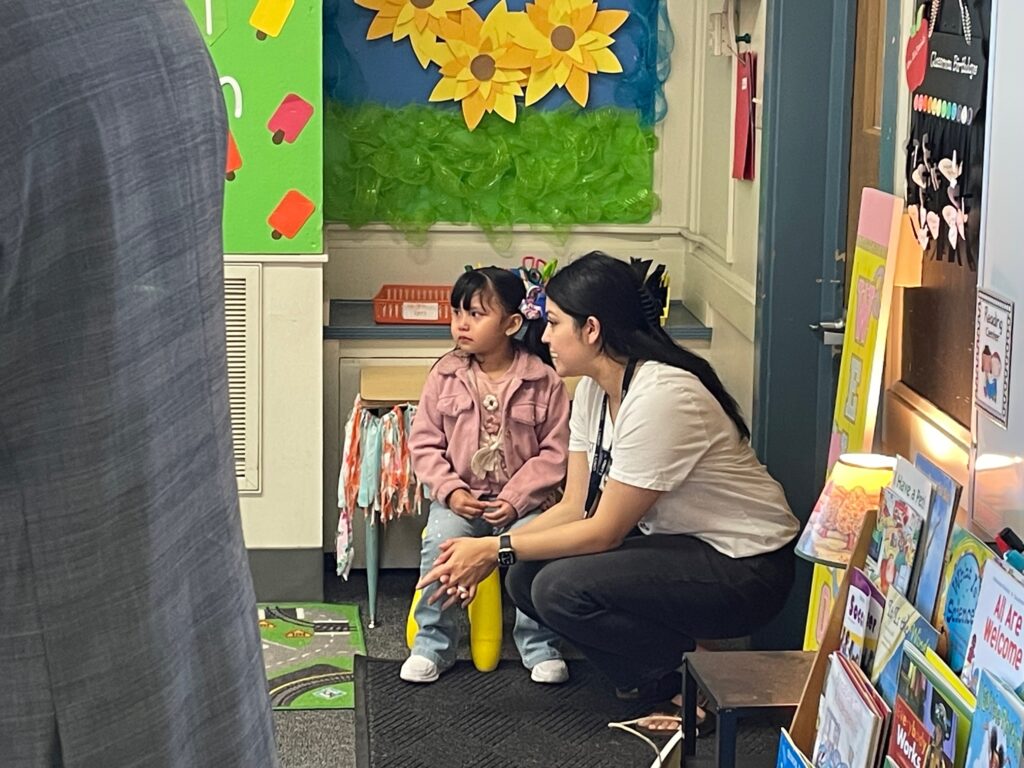A teacher’s aide sits with a kindergartner on the first day of school at George Washington Elementary School in Lodi Unified.
Diana Lambert
In today’s world, families have numerous school choices for their children and often rely on the experiences of neighbors, family and friends for advice. Families’ perceptions of the school — how they feel when they walk into the front office, their ability to provide feedback and feel heard and valued, and their access to school staff — are all crucial to improving student attendance, engagement and performance.
This might sound a lot like customer service, and that’s precisely what it is.
Just as in the business world, positive interactions between schools and their families directly influence satisfaction, loyalty and trust. According to the K12 Insight report on customer service in schools, these interactions can enhance student outcomes, enrollment, attendance and behavior.
Children in poverty, children of color and children with disabilities are three times more likely to be chronically absent. A welcoming school that goes the extra mile to create a sense of belonging and build bonds with families can take proactive measures to address attendance challenges.
This school year, schools should aim to create and nurture a sense of belonging and common purpose with families and the community. Here are some actionable suggestions:
Create a family-friendly environment
Families should feel comfortable touring and visiting the school. A welcoming environment includes convenient parking, clear signage, cleanliness, a friendly and helpful front office staff, a comfortable and inviting waiting area, translated materials, posted family engagement activities and events, and flyers informing families of enrichment opportunities available after school and in the community. When interacting with the school, families should find the staff knowledgeable, helpful and responsive to their concerns. To go the extra mile, schools can:
- Advertise principal office hours when parents and students can stop by.
- Promote networking among families during an open house by organizing grade-level meet-and-greet events and team-building activities.
- Use student pickup and drop-off times as golden opportunities to make quick and friendly connections with families.
- Post empowering messages for families on the school outdoor sign.
- Actively recruit families to support decision-making and help identify the school’s vision and goals.
Enhance family engagement with clear and honest communication
Effective communication with families is clear, relevant and personalized. Go beyond good intentions and engage in meaningful conversations that can lead to improved student learning.
Teachers can make a great first impression before school starts or at the beginning of the year by making a welcome phone call, sending a postcard, email, letter or any other form of communication that helps families get to know their child’s teachers.
Encourage teachers to be relatable by sharing tidbits of their own lives; being a real person goes a long way in building relationships. Let families know the best way to contact their teacher for questions, guidance or updates on student learning progress.
Transparent and honest communication builds trust. Prioritize communication linked to learning. Share student progress data promptly, inform families when and how students will be tested, and show parents specific activities and strategies for home support. Report cards and parent-teacher conferences are not enough; families need concrete and personalized information and guidance to support learning. To go the extra mile:
- Implement quarterly listening circles with diverse groups of families to value parents’ perspectives and ideas and support school improvement.
- Anticipate communication barriers by understanding each family’s preferred language and communication method.
- Create school policies to allow teachers to regularly connect with families and build time into the schedule to make it possible.
Expand engagement access for all families
Traditionally, schools collect family engagement data based on family attendance at school events and activities. Often, this means counting the regulars — the ones who come time after time. This school year, challenge your team to count the families who were unable to attend the event, especially if the event is focused on student learning.
Divide the number of absent families by grade level and ask teachers to reach out to their families to share the information they missed and build trust. Take this opportunity to learn more about the family, build trust, and open new lines of communication. Create space for teachers to share what they learn with their grade-level team. To go the extra mile:
- Adjust engagement opportunities using family feedback and suggestions from prior years.
- Leverage nonclassroom staff to facilitate mini-make-up sessions for families who were unable to attend the learning-focused events.
Genuine family engagement happens away from school — it happens at the dinner table, in car rides and during everyday parent-child interactions and family dynamics. Strengthening relationships with families can enrich the way families support learning and provide valuable insights into the children you teach.
There’s something incredibly heartwarming about reading parents’ social media posts expressing their appreciation for their child’s school. These parents highlight their favorite and trusted teachers, describe a sense of community and belonging, and invite new families to join in on school activities, volunteer opportunities, and decision-making committees. Their loyalty to the school is unmistakable.
Efforts like those listed above can enable schools to build stronger, more supportive communities that foster student success and create a welcoming environment for everyone involved.
Let’s make this school year the best one yet by going the extra mile for our families.
•••
Maria Paredes is a senior research associate on WestEd’s Family and Community Engagement team. A version of this post first appeared in the WestEd Bulletin in August and is reposted here with permission.
The opinions in this commentary are those of the author. We welcome guest commentaries with diverse points of view. If you would like to submit a commentary, please review our guidelines and contact us.

